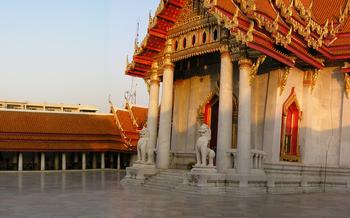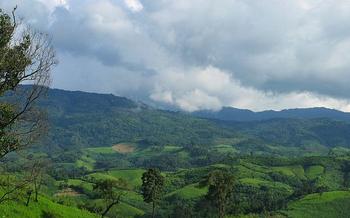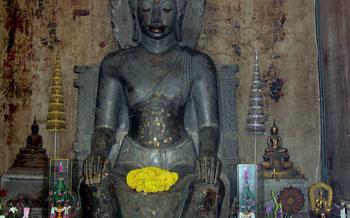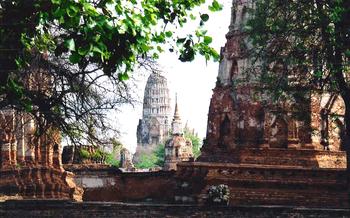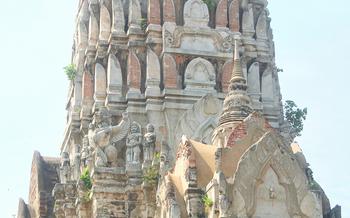
Wat Kaew Korawaram
- History and Significance of the Temple
- Admission and Fees
- Exploring the Temple Grounds
- The Grand Ubosot
- The Impressive Chedi
- The Revered Buddha Images
- The Serene Gardens and Landscapes
- The Ordination Hall and Monks' Quarters
History and Significance of the Temple
Wat Kaew Korawaram, also known as "Crystal Temple", is an awe-inspiring Buddhist temple located in Krabi, Thailand. Its rich history dates back to the mid-20th century when a revered monk, Ajahn Thuad, embarked on a journey to establish a temple that would serve as a spiritual sanctuary for the local community. With the support of devoted followers, Ajahn Thuad selected a serene location surrounded by lush greenery and laid the foundation for what would become a beacon of Buddhism in Krabi.
The temple's significance lies in its unique architecture, which blends traditional Thai elements with modern touches. The intricate carvings, vibrant murals, and glistening crystal embellishments create a captivating visual spectacle that has earned Wat Kaew Korawaram its reputation as one of the most stunning temples in Thailand. It serves as a place of worship, meditation, and community gatherings, attracting both local residents and visitors from around the world.
Admission and Fees
Visiting Wat Kaew Korawaram is free of charge, allowing travelers to experience its beauty and tranquility without financial barriers. However, donations are gratefully accepted to support the temple's upkeep and ongoing initiatives. These donations play a vital role in maintaining the temple's pristine condition and preserving its cultural heritage for generations to come.
While there are no entrance fees, it's customary to offer a small donation as a gesture of respect and appreciation. Visitors can contribute to donation boxes located throughout the temple grounds, contributing to the temple's continued preservation and development.
The temple's operating hours are generally from 8:00 am to 5:00 pm daily, providing ample time for visitors to explore its serene grounds and immerse themselves in its spiritual atmosphere. It's worth noting that the temple may occasionally close for special events or renovations, so it's advisable to check in advance to avoid any inconvenience.
Exploring the Temple Grounds
Wat Kaew Korawaram's extensive grounds are a testament to its rich history and spiritual significance. As you enter the complex, a detailed map or layout can help you navigate the various structures and landmarks. Start by admiring the wihan, a multi-purpose hall used for religious ceremonies and community gatherings. Its intricate carvings and colorful murals depict scenes from Buddhist mythology.
Next, explore the kuti, or monks' residences, which line the perimeter of the temple. These simple yet serene dwellings provide a glimpse into the daily lives of the monks who call Wat Kaew Korawaram home. Don't miss the sala kan parian, a covered pavilion used for meditation and chanting, offering a peaceful spot for visitors to find inner tranquility.
For a unique perspective, climb the narrow staircase to the bell tower. From this vantage point, you'll be rewarded with panoramic views of the temple complex and the surrounding countryside. Keep an eye out for hidden gems like the sacred tree, believed to possess spiritual powers, or the ancient well, which is said to have miraculous healing properties.
Whether you choose to explore the temple grounds on a guided tour or at your own pace, there's always something new to discover. Let the serene atmosphere envelop you as you wander through this sacred space, immersing yourself in its rich history and spiritual significance.
The Grand Ubosot
The heart of Wat Kaew Korawaram lies in its grand Ubosot, or ordination hall. This sacred structure serves as the primary venue for religious ceremonies, including ordinations, chanting sessions, and meditation retreats. As you step into the Ubosot, you'll be awestruck by its intricate architectural design and the serene atmosphere that envelops the space.
The Ubosot's exterior boasts intricate carvings and sculptures that depict scenes from Buddhist mythology. The roof, adorned with colorful ceramic tiles, glistens in the sunlight, creating a mesmerizing spectacle. Upon entering the Ubosot, your gaze will be drawn to the grand Buddha image enshrined within. This revered statue, crafted with exquisite detail, exudes an aura of peace and tranquility.
The walls of the Ubosot are adorned with stunning murals and paintings that narrate the life of Lord Buddha and significant events in Buddhist history. These vibrant artworks serve as a visual testament to the temple's rich cultural heritage and provide a glimpse into the teachings and stories that shape the Buddhist faith.
As you explore the Ubosot, you'll notice several smaller Buddha images arranged around the main statue. Each of these images holds a unique significance and represents different aspects of Buddhist teachings. Devotees often offer prayers, light candles, and make offerings in front of these revered figures, seeking blessings and guidance in their lives.
The Ubosot is not only a place of worship but also a center for community gatherings and events. During important Buddhist festivals, the Ubosot transforms into a vibrant hub of activity, hosting chanting sessions, sermons, and special ceremonies. Visitors are welcome to participate in these events and immerse themselves in the temple's vibrant spiritual atmosphere.
The Impressive Chedi
Standing tall and majestic within the temple grounds, the chedi is a sacred monument that holds deep religious significance. Its design is intricate and symbolic, representing the Buddha's path to enlightenment. Constructed with meticulous care, the chedi showcases the architectural prowess of the temple's builders.
The chedi's towering structure is adorned with intricate carvings and embellishments, each holding a unique meaning. The symbolism embedded in these details narrates the journey of the Buddha, from his birth to his attainment of Nirvana. Visitors marvel at the artistry and craftsmanship that went into creating this sacred monument.
At the heart of the chedi lies a chamber that houses relics or sacred objects associated with the Buddha or revered monks. These relics are considered highly مقدس and are believed to possess spiritual power. Devotees pay homage to the chedi, offering prayers and making offerings, seeking blessings and protection.
For those who are able to climb to the top of the chedi, a breathtaking view awaits. The elevated perspective offers a panoramic vista of the temple complex and the surrounding landscape. This vantage point allows visitors to fully appreciate the grandeur of the temple and its harmonious coexistence with nature.
The Revered Buddha Images
The Wat Kaew Korawaram is home to several sacred Buddha images that attract devotees and visitors from around the world. The main Buddha image, known as Phra Buddha Sihing, is a highly revered and iconic statue. This life-sized bronze image exudes a serene and compassionate expression, capturing the essence of the Buddha's teachings. Its intricate details and craftsmanship showcase the artistic prowess of ancient Thai artisans.
Smaller Buddha images, each with distinct features and significance, are also enshrined within the temple grounds. These images represent different incarnations or aspects of the Buddha, such as the laughing Buddha, the reclining Buddha, and the standing Buddha. Each image holds a special place in the hearts of devotees, who offer prayers, make offerings, and seek blessings from these sacred representations of the Buddha.
Legends and stories associated with these Buddha images have been passed down through generations, adding to their mystique and allure. Some believe that the Phra Buddha Sihing image possesses miraculous powers and has been instrumental in protecting the temple and the surrounding area from harm. Another legend tells of a miraculous event where the image was discovered floating on the river and was subsequently enshrined within the temple.
Devotees often perform rituals and offerings to pay homage to the Buddha images. These rituals may involve lighting candles, offering flowers, or reciting prayers. The serene atmosphere of the temple, coupled with the presence of these sacred images, creates a powerful spiritual energy that many find deeply moving and uplifting.
The Serene Gardens and Landscapes
Surrounding the temple, visitors are greeted by meticulously maintained gardens that exude an aura of tranquility and serenity. These gardens serve as a verdant oasis, offering a welcome respite from the bustling streets of Krabi. Take a leisurely stroll along the winding paths, admiring the vibrant blooms of tropical flowers that adorn every corner. Ponds and fountains dot the landscape, their gentle murmur creating a soothing ambiance. Sculptures, statues, and other artwork harmoniously blend with the natural surroundings, adding a touch of artistic flair to the serene setting. Discover peaceful spots amidst the gardens, inviting you to sit down, meditate, and immerse yourself in the tranquil atmosphere. Let the serenity of the gardens wash over you, leaving you feeling refreshed, rejuvenated, and deeply connected to the spiritual essence of Wat Kaew Korawaram.
The Ordination Hall and Monks' Quarters
The ordination hall, also known as the "sim," holds a significant place within the temple complex. It serves as the sacred space where Buddhist monks undergo the ordination ceremony, marking their formal entry into the monastic life. The ordination hall is typically a large, open structure with a raised platform in the center. During ordination ceremonies, the candidates for monkhood gather on this platform and receive their vows from the presiding monks.
Adjacent to the ordination hall are the monks' quarters, where the resident monks live and study. These quarters provide a simple and austere living environment, reflecting the Buddhist principles of detachment and renunciation. Visitors may have the opportunity to observe the daily routines of the monks, including their meditation and chanting practices. It is important to respect the privacy of the monks and maintain a respectful distance while observing their activities.
Interacting with the monks can be a rewarding experience for visitors seeking a deeper understanding of Buddhism and monastic life. Visitors may have the chance to ask questions about the monks' experiences and receive blessings or teachings. It is customary to show respect by bowing to the monks and addressing them with the appropriate honorifics.

